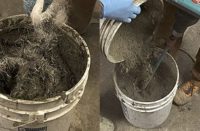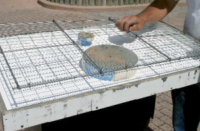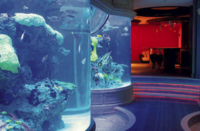 |
 |
 |
Before Dana Boyer discovered concrete, paint was her artistic medium. Her parents painted for a living, and she followed, specializing in faux techniques, murals and custom airbrushing.
She was perfectly happy painting cars and Harley Davidsons, but a home improvement project changed everything.
Just after moving to Arizona, Boyer decided to replace the white carpet in her home with a concrete floor that would better handle the dirt and rocks tracked in by her motorcycle-racing husband and her dogs.
She wanted just a quick lesson so she could custom paint her floor, but it turned out to be an introduction to the diversity of concrete. Boyer was hooked. “It just took over my life. It totally swallowed up my life and consumed me. I just loved it.”
Paint was out and concrete was in. Now, Boyer is the owner of ConcretiZen, based in Apache Junction, Ariz. She does it all — art pieces, driveways, pool decks, countertops, floors. She takes residential and commercial jobs, coloring, texturing, stamping, polishing, sandblasting or engraving concrete.
The wide variety of effects Boyer produces began with Mike Miller, the founding father of the Concretist group. Miller, a leader in developing innovative staining techniques, asked Boyer to work with him. She started at the bottom, doing cleaning and scrubbing and other low-level jobs, but kept her eyes open and learned quickly. Miller, whom she describes variously as “an incredible mad genius guy,” “a spinning vortex,” “a real blessing,” “a kick in the pants,” and “the Tazmanian devil on quadruple espresso,” taught her everything. “He doesn’t take that kind of time with everyone,” she says. “I was very fortunate.”
 |
 |
 |
 |
Miller asked Boyer to join the Concretist group, a loose organization of artists and craftsmen who pool their ideas and talents to create amazing decorative concrete work. Each artisan also works separately, and each of them is always experimenting with techniques and products to produce new decorative effects. The Concretist group’s motto is “Concrete & Architecture + Art = The Concretist.”
Boyer considers concrete beautiful, and views it as a huge blank canvas. Over the years, she has learned to work with the dozens of factors that affect how a project comes out, and appreciates the unique, changeable properties of concrete.
 |
 |
  |
She has worked with designers and architects all over the country on projects large and small. Whether it’s a home patio or a mall, they’re all fascinating to her because each one is an opportunity for innovation. “Everything that I do is custom,” she says. “I just don’t throw a color down and say that’s it. If you’re looking for that kind of contractor, that’s not me. I don’t have it in me.”
She makes use of all types of coloring systems: integral colors, color hardeners, chemical stains and more. She creates her own palette and can produce dazzling effects — a floor in brilliant teal blue, or a natural-looking floor with subtle variations of color.
Boyer recently recreated Vincent van Gogh’s famous painting, “The Starry Night,” on the floor of a doctor’s office in Phoenix. One of her concrete floors may look like a stone path, another may resemble an array of different colored blocks, a scattering of fall leaves or wooden planks. Images of fish, kelp and glass bubbles have made their way into Boyer’s work. Textures may resemble marble, rawhide or elegant alabaster.
Boyer also designed a wild-looking conference table for The Stamp Store, an Oklahoma City business that provides decorative concrete training and materials. The table features green and blue acid stains with gold accents. Boyer herself still shakes her head in amazement. “I look at it and I’m like, ‘My God, I did that?’ I just can’t get over how beautiful it is.”
She says her toughest challenge is not the hands-on concrete work, but dealing with customers who aren’t sure what they want. Customers should expect variability, not uniformity, since concrete is an unknown variable with a mind of its own. Boyer tries to educate each client at the outset, explaining that she can’t possibly match a one-inch color chip across 10,000 square feet of flooring.
 |
 |
One challenge she has not had to worry about is working as a woman in a male-dominated field. “On the most part, the guys have really been good to me,” she says, and she feels grateful for the encouragement and mentoring she has received from some of the top experts in the decorative concrete industry.
Boyer is eager to learn as much as she can about her favorite artistic medium, and is a strong advocate for continuing education in the trade. Those who don’t want to learn more are selling themselves short, she says. Boyer says she’s like a 10-year-old kid, always learning, always trying new products and constantly asking why. “I want to know everything I can,” she says, adding, “Nothing takes the place of good old trial and error.”
She’d like to do more sculpture with concrete, and is always open to new ideas. The broad array of colors, textures and applications for concrete are just beginning to be recognized.
“People have yet to realize the full potential of concrete and concrete products,” she says, “It’s an untapped market.”












